Publications
Michigan Merit Curriculum
2016. Are Expectations Alone Enough? Estimating the Effect of a Mandatory College-Prep Curriculum in Michigan
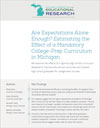
Abstract
This paper examines the impacts of the Michigan Merit Curriculum (MMC), a statewide college preparatory curriculum that applies to the high school graduating class of 2008 and later. We use a student, longitudinal database for all public school students in Michigan for the main analyses, and complement this with analyses from a state-year panel. The study employs several non-experimental approaches, including a comparative interrupted time series and a synthetic control method. Our analyses suggest that the higher expectations embodied in the MMC has had little impact on student outcomes. Looking at student performance on the ACT, the only clear evidence of a change in academic performance comes in science. Our best estimates indicate that ACT science scores improved by 0.2 points (or roughly 0.04 standard deviations) as a result of the MMC. Students who entered high school with the weakest academic preparation saw the largest improvement, gaining 0.35 points (0.15 standard deviations) on the ACT composite score and 0.73 points (0.22 standard deviations) on the ACT science score. Our estimates for high school completion are very sensitive to the sample and methodology used. Some analysis suggests a small negative impact on high school graduation for students who entered high school with the weakest academic preparation, but other analysis finds no such effect.
Download this brief. (Adobe PDF)
2012. The Michigan Context - High School Attainment and College Enrollment Across the State
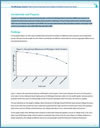
Abstract
In order to understand the educational landscape in which the Michigan Merit Curriculum (MMC) was enacted, we examine the attainment trajectory of high school students in Michigan. These findings will provide a baseline against which we can interpret any impacts of the MMC. We use state administrative data describing students who began high school in the academic years 2004-2005 through 2007-2008.
Download this brief. (Adobe PDF)
2012. Impacts of the Michigan Merit Curriculum on Student Outcomes - Preliminary Findings from the First Cohort
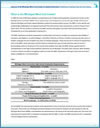
Abstract
Based on the first cohort of students exposed to the requirements of the MMC for their entire high school career, we find that the MMC led to small increases in the academic performance of already high-achieving students, with positive effects in science and reading, as well as in ACT math. We find little or negative impacts on the academic performance of low-achieving students, with the largest negative effects appearing in non-MMC subjects (e.g., ACT writing).
The MMC appears to have caused some students to extend their stay in high school beyond the traditional four years, perhaps in an effort to meet the more rigorous curricular requirements. The MMC also slightly increased the five-year dropout rate. As more ninth-graders move through high school, we will be better able to estimate the MMC's impact on the college-going behavior of recent Michigan graduates.
Going forward, we plan to closely examine patterns of student-level course-taking to understand if and how the effects of the MMC vary by district. We will also compare the experiences of Michigan students under the MMC to students in other states with similar reform efforts.
Download this brief. (Adobe PDF)
2010. Mandating Merit: Assessing the Implementation of the Michigan Merit Curriculum
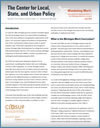
Abstract
On April 20, 2006, Michigan governor Jennifer Granholm signed into law the Michigan Merit Curriculum (MMC) establishing some of the most ambitious core graduation requirements in the nation. The curriculum requires all students in the graduating class of 2011 and beyond to obtain sixteen credits in specific academic areas. While these requirements were designed to prepare Michigan high school graduates for college-level courses while positioning the state for a 21st century economy (Michigan Department of Education, 2006b), a number of problems have challenged schools implementing the MMC.
Download the Report (Adobe PDF)
Other Topics
2016. Using Longitudinal Data to Understand Income Gaps in Educational Outcomes
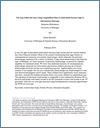
Abstract
In the US, gaps in educational achievement between high-income and low-income children have been rising for decades. Much of the research documenting these gaps focuses on contemporaneous measures of economic disadvantage, which understate the persistent disadvantage experienced by a subset of children. Using school administrative data from the state of Michigan, we create measures of persistent disadvantage, as proxied by repeated eligibility for subsidized meals. We show that traditional measures of contemporaneous disadvantage understate the achievement gap between children growing up in chronic disadvantage and those having never experienced poverty. Approximately one in four students in our sample who are ever economically disadvantaged are disadvantaged in every year between kindergarten and 8th grade. These children have significantly worse education outcomes, scoring 0.94 standard deviations below never-poor children on standardized tests. The gap based on persistent disadvantage is comparable to that estimated by Reardon (2011) between individuals with family income in the 90th percentile to those with income in the 10th percentile, while the test score gap measured using contemporaneous measures approximates the 90/50 test score gap.
Download this working paper. (Adobe PDF)
2015. The Role of Non-Cognitive Skills on Educational Outcomes Measured by Skipping Questions on School Exams
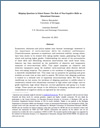
Abstract
Economists, educators and policy-makers have become increasingly interested in the importance of socio-emotional skills for students’ performance. Conscientiousness, openness to experience, and emotional stability, among others, have been shown to be related with taking harder classes, graduating from high school and earning higher grades. Understanding the nature of the accumulation of these skills and identifying education interventions that could boost them, however, has been restricted by the availability of objective and inexpensive measures of socio-emotional skills. This paper proposes an objective and relatively inexpensive proxy for students’ socio-emotional skills directly derived from test-taking behavior. The measure is the incidence of skipping questions on a statewide standardized test. This exam has no penalties for guessing and gives students as much time as they need to answer. We believe that skipping questions is related to a reduced level of important socio-emotional skills. We find that, conditional on test scores, the incidence of skipping questions in middle school is consistently related with educational outcomes in high school and college, such as grade repetition, high school drop-out, on-time graduation and going to a 4-year college. These results are robust to the definition of skipping incidence and to the measurement of cognitive ability as captured by test scores.
Download this working paper. (Adobe PDF)
2015. Marginal Pricing and Student Investment in Higher Education

Abstract
This paper examines the effect of marginal price on students’ educational investments using rich administrative data on students at Michigan public universities. Marginal price refers to the amount colleges charge for each additional credit taken in a semester. Institutions differ in how they price credits above the full-time minimum (of 12 credits), with many institutions reducing the marginal price of such credits to zero. We find that a zero marginal price induces a modest share of students (i.e., 7 percent) to attempt up to one additional class (i.e., 3 credits) but also increases withdrawals and lowers course performance. The analysis generally suggests minimal impacts on credits earned and the likelihood of meeting “on-time” benchmarks toward college completion, though estimates for these outcomes are less precise and more variable across specifications. Consistent with theory, the effect on attempted credits is largest among students who would otherwise locate at the full-time minimum, which include lower-achieving and socioeconomically disadvantaged students.
Download this working paper. (Adobe PDF)
2014. Impacts of the International Baccalaureate’s Primary Years Program on Student Achievement in Michigan and North Carolina
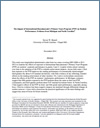
Abstract
This study uses longitudinal administrative data from two states covering 2005-2006 to 2011-2012 to examine the effects of exposure to International Baccalaureate’s Primary Years Program (PYP) on students’ academic performance in grades 3 and 5. I exploit within-school variation over time in the adoption of the PYP to estimate achievement impacts. Across both states, I find that exposure to the PYP improves the reading performance of economically disadvantaged third-graders (by about 0.10 standard deviations), with little evidence of any offsetting, harmful effects on the reading achievement of other students. Yet, I arrive at discordant conclusions about the effects of the PYP on students’ mathematics performance: In Michigan, estimates suggest that fifth-graders exposed to the PYP perform about the same as their non-PYP counterparts, and third-graders perform about 0.07 standard deviations better. In North Carolina, I find negative effects of the PYP on third- and fifth-grade math performance, especially among boys. I find no evidence that these negative impacts are mediated through differential changes in teacher turnover. I close with a discussion the practical significance of the main findings and suggest key areas of focus for future research.
Download this working paper. (Adobe PDF)
2014. The Effects of School Spending on Educational Attainment
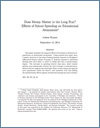
Abstract
This paper examines the long-run effects of increases in education expenditures on educational attainment. Using student-level panel data, I exploit variation in the school funding formula imposed by Michigan’s 1994 school finance reform, Proposal A. Students exposed to additional funding were more likely to enroll in college and earn a postsecondary degree. The increases in spending lowered class sizes, raised teacher salaries, and substantially reduced the ratio of pupils to administrators. School districts targeted the additional dollar toward schools serving less poor populations within the district, and consistent with this finding, the postsecondary effects appear concentrated among non-poor students.
Download this working paper. (Adobe PDF)
2014. Impacts of Kindergarten Starting Age and Compulsory Schooling Laws on Postsecondary Enrollment, Choice, and Persistence in Michigan
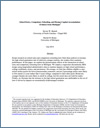
Abstract
Extant research on school entry and compulsory schooling laws finds these policies to increase the high school graduation rate of relatively younger students, but weaken their academic performance. In this paper, we explore the postsecondary effects of the interaction of school entry and compulsory schooling laws in Michigan. We employ a regression discontinuity (RD) design using longitudinal administrative data to examine impacts on high school performance, college enrollment, choice, and persistence. On average, we find that children eligible to start school earlier persist for fewer postsecondary semesters, and are 2 percentage points more likely to first attend a 2-year (rather than 4-year) college, compared to their older peers. Relatively younger females are more likely to enroll in college, but this result does not hold for males. Finally, we illustrate that the increase in the high school graduation rate attributable to this set of laws is driven by impacts on economically disadvantaged students.
Download this working paper. (Adobe PDF)
2013. The Missing Manual: Using National Student Clearinghouse Data to Track Postsecondary Outcomes
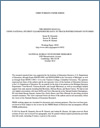
Abstract
This paper explores the promises and pitfalls of using National Student Clearinghouse (NSC) data to measure a variety of postsecondary outcomes. We first describe the history of the NSC, the basic structure of its data, and recent research interest in using NSC data. Second, using information from the Integrated Postsecondary Education Data System, we calculate enrollment coverage rates for NSC data over time, by state, institution type, and demographic student subgroups. We find that coverage is highest among public institutions and lowest (but growing) among for-profit colleges. Across students, enrollment coverage is lower for minorities but similar for males and females. We also explore two potentially less salient sources of non-coverage: suppressed student records due to privacy laws and matching errors due to typographic inaccuracies in student names. To illustrate how this collection of measurement errors may affect estimates of the levels and gaps in postsecondary attendance and persistence, we perform several case-study analyses using administrative transcript data from Michigan public colleges. We close with a discussion of practical issues for program evaluators using NSC data.
Download this working paper. (Adobe PDF)
2012. The Michigan Merit Curriculum and Teacher Compositional Change

Abstract
In the spring of 2006 the state of Michigan enacted the Michigan Merit Curriculum (MMC) with the intent to increase the rigor of student course-taking, improve student performance, and increase college matriculation rates. This policy brief focuses on corresponding changes in the composition of teachers in Michigan high schools from the time period prior to the introduction of the MMC to after implementation. Because schools were required to offer more rigorous coursework for students, they may have also needed to hire more teachers to teach the new courses or otherwise respond to the demands of the reform. Our goal is to understand how schools have managed the changing human resources requirements associated with the MMC as a way to contextualize other findings about changes in student course-taking, academic performance, and variation in district outcomes.
To answer these questions, we use state administrative data from the Registry of Educational Personnel (REP) about teacher hiring and personnel assignments from 2004 to 2011. Following convention in the literature, we report student-teacher ratios in this brief. However, it is important to note that while these ratios represent statewide access to different kinds of teachers, they do not indicate actual class sizes.
Download this brief. (Adobe PDF)
Forthcoming Papers
- The Effect of Early Information on College Applications among Low-Income, High Achieving Students
- Improving Chronically Underperforming Schools? Regression-Discontinuity Evidence from NCLB Waivers
- Developing and Evaluating a College-Application Course in Michigan
- The Effect of Information about Student-Loan Forgiveness on Teacher Retention in High-Needs Schools in Michigan
- What is the Effect on College Enrollment of Providing High School Students with Information about College and the Application Process?
- Improving Chronically Underperforming Schools? Regression-Discontinuity Evidence from NCLB Waivers
- Measuring School Performance for Excellent Schools Detroit's Report Cards
- Measuring and Understanding the Effectiveness of Michigan Charter Schools
- The Impact of Michigan Promise Zones on Educational Outcomes, School Funding, and Student Mobility
- Improving on the Student-Teacher Ratio: A Direct Measure of Class Size in Michigan Using Transcript-Level Data
- Participation in Advanced Math Courses and Student Achievement in High School and College
- Student Achievement in Career and Technical Education in Michigan
- Education Pathways and Labor Market Outcomes for Michigan’s Community College Students
- Examining the Impact of Plant Closings on Postsecondary Choice in Michigan
- The Causes and Consequences of Teacher Turnover: New Evidence from Michigan
- The Effect of Grade Structure on Student Performance: Middle Schools VS. K-8
